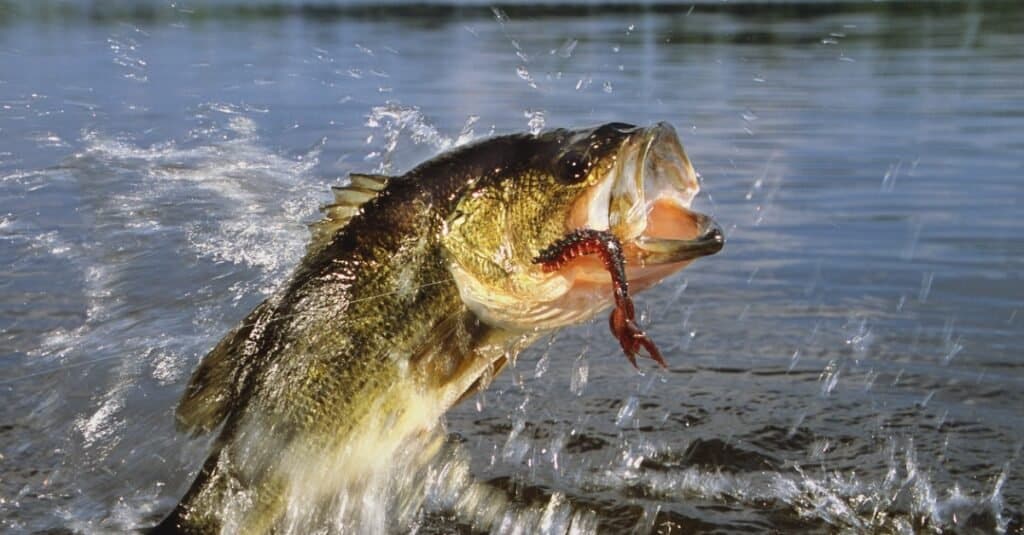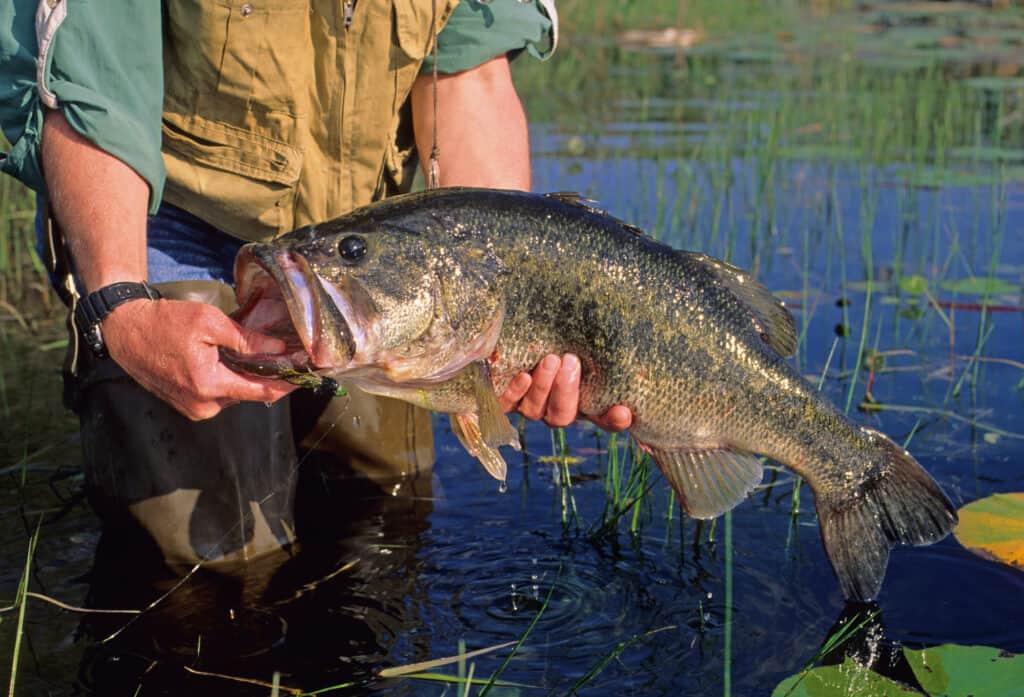There’s hardly an angler who has yet to have a good catch of the largemouth bass. The wide availability of this freshwater game fish is one of the reasons bass fishing is popular. Bass species are readily accessible to most people in North America. Thus, bass fishing is a favorite pastime for many Americans.
The St. Lawrence River, the Great Lakes, Hudson Bay (Red River), and the Mississippi River basin all fall within the range of largemouth bass in North America. They are also present along the Atlantic coast from North Carolina to Florida and up into northern Mexico.
Catching a largemouth bass and reeling it in is an exhilarating experience. We will take you deep diving into freshwater to learn about one of its most popular species.

About Largemouth Bass

Largemouth bass hunt by opening their large mouths and sucking the prey in.
©iStock.com/stammphoto
The largemouth bass, Micropterus salmoides, is a black bass species with an impressive geographical range. Although it’s native to the eastern and central United States, southeastern Canada, and northern Mexico, it has been introduced in non-native areas. This includes Africa, Asia, Europe, and South America.
The largemouth bass is the state freshwater fish of Florida and Alabama and the state fish of Georgia and Mississippi.
Thanks to its distribution across regions, the carnivorous freshwater sportfish of the sunfish (Centrarchidae) family is known by many other names. Some include black bass, bigmouth bass, green trout, Florida largemouth, and bucketmouth.
It can be identified from the most closely related species (such as smallmouth bass, Guadalupe bass, and spotted bass) by the upper jaw that extends past the eye.
Largemouth bass has a dark olive green back, and the underside color varies from light green to white. Dark blotches on either side of the fish’s midsection form a horizontal stripe. The spiny front dorsal and the soft-rayed rear dorsal are clearly separated. The front dorsal has nine spines, while the back dorsal contains 12-13 soft rays.
Size
In their first year, largemouth bass grow between 4 and 6 inches (10 and 15 cm). The second year records between 8 and 12 inches (20 and 30 cm) growth, and they can grow up to 16 inches (40 cm) in three years. Male largemouths are generally smaller than females.
The body height of largemouth bass measures between 4 and 8 inches (10.2-20.3 cm). Its overall length and weight range from 15 to 30 inches (38-76 cm) and 1.8 to 30 pounds (0.8-13.6 kg), respectively. Its average lifespan is 10-16 years.
Habitat
Lakes, streams, rivers, and ponds are where largemouth bass reside. They prefer still, clean waters with supple, shallow bottoms. Despite their tendency to remain in shallow water (1-13 feet or 0.3–4 meters deep), largemouth bass migrate to deeper water (16- 49 feet or between 5 and 15 meters) during the winter.
Dense vegetation is helpful to them for both fending off predators and acting as predators. Although largemouth basses are at the top of the food chain within their ecosystem, they can be preyed upon when young.
Feeding
Baitfish, scuds, shrimp, and small insects make up the majority of the diet of young largemouth bass. However, the bass eats bigger prey as it gets older. Small water birds, snakes, frogs, shad, bluegill, crawfish, snails, young alligators, lizards, and snails are examples of this.
Largemouths feed primarily on young fish in the larger, deeper water bodies around the nation. These fish range from sunfish to shiners to yellow perch, among others. In addition, walleye, striped bass, catfish, and trout are included.
Largemouth Fishing in Louisiana

Louisiana features a wide variety of bass-fishing locations.
©iStock.com/stammphoto
Largemouth bass fishing is among the most thrilling types of freshwater fishing. Anglers keep returning, among other things, because of intense fights, topwater explosions, and large-sized bass. The apex predator fish will eat anything, including small birds, insects, reptiles, and other fish.
The highly prized largemouth bass is particularly dear to anglers in the Southeast U.S. Although the fish develops the ability to recognize and avoid a specific bait after surviving for a while, bass anglers can count on the aggressive way they protect their territory. This explains why they attack anything they believe to be alive.
Louisiana earned the moniker “Sportsman’s Paradise” with its fishing and hunting options. Many rivers, streams, lakes, reservoirs, wetlands, and estuaries spread across thousands of miles are interspersed throughout the naturally beautiful terrain.
There’s a myriad of ponds, vast mud flats, shallow bays, and canals for shallow-water fly anglers. The state also features a wide variety of bass-fishing locations, including rivers, reservoirs, bayous, and lakes. In addition, the Pelican State has a bass fishing hole for you whether you like to troll the shoreline or cast from the bank.
Toledo Bend, Lacassine Pool, Cypress Bayou Reservoir, Red River, Lake Salvador Poverty Point, Caddo Lake, Grand Bayou Reservoir, and Lake Cataouatche are some of the best places to catch largemouth bass in the Sportsman’s Paradise.
The Largest Largemouth Bass Ever Caught in Louisiana

Caney Lake in Louisiana is known for record-breaking largemouth bass.
©iStock.com/stammphoto
The largest largemouth bass ever caught in Louisiana weighed in at 15.97 pounds. On February 12, 1994, 40-year-old Greg Wiggins and his fishing partner Mark Smith launched Wiggins’ boat into the brisk Caney Lake waters on a freezing 27-degree morning. The day started with Wiggins demonstrating a jig to Mark at a good location.
After many hours without luck, they stopped to get food and returned to give it another shot. Little did they know that Wiggins would reel a record-breaking 15.97 pounder. Then, when Wiggins was flipping a jig next to a stump, he felt the thud of a bass that would propel him to the top of Louisiana’s Top 10 list.
Tommy Forester had caught a massive 15.54 largemouth bass in February 1993 at the same Caney Lake.
Six of the top 10 basses mentioned in the official and current Louisiana freshwater fish records between 1993 and 1996 were caught on Caney Lake, with Greg Wiggins’ enormous catch placing first.
29 years later, he maintains the enviable top position on the state’s fish records for largemouth bass.
A Large Breed of Bass
The largemouth Wiggins caught was confirmed to be a Florida strain largemouth bass after he gave the bass to the Louisiana Department of Wildlife and Fisheries to identify her strain. But this wasn’t a mere coincidence.
The Louisiana Department of Wildlife and Fishery stocked the state’s lakes with Florida-strain largemouth in the mid-1980s as a part of efforts to expand its bass fisheries.
The weight of the state record largemouth had remained at about 12 pounds for many years. However, this established record was shattered entirely in 1992 when the new Florida-strain bass started to earn a reputation.
A quick glance at the Louisiana state fish records, it’s safe to call the Caney Lake “the lake of records.” It’s perhaps, the most well-known of the Florida-strain-boosted lakes.
16 of the top 20 largemouths in the state by records were caught in Caney Lake, including Wiggins’ top-ranked fish. Interestingly, the fish were all captured after March 1992.
Only 1.66 pounds separate the biggest largemouth bass from the 20th place, demonstrating how Florida-strain bass have dominated the rankings. However, 18 other fish separate them with exceptional records.
However, by 1996, Caney Lake started to lose ground. This allowed other lakes to show off their Florida-boosted bass capabilities. In March 1998, Kraig Welborn caught a 14.68-pounder off of Toledo Bend Reservoir. Brett Fontenot recorded a 15.05 out of Miller’s Lake.
The Largest Largemouth Bass Ever Caught in the World
Manabu Kurita and George Washington Perry both hold the International Game Fish Association world record for largemouth bass, despite catching their fish 77 years apart on 2 different continents.
On July 2, 2009, Kurita caught a 22-pound bass from Lake Biwa, Japan’s largest freshwater lake, regarded as one of the oldest in the world.
Following months of speculation and investigation, the IGFA declared Kurita’s catch a tie for the group’s all-tackle world record.
Representatives from the International Game Fish Association and the Japanese Game Fish Association collaborated to review Kurita’s application and question claims that the fish was captured in an off-limits location.
The angler was subjected to a polygraph test by the IGFA to determine the details of his capture, and he was successful.
The IGFA mandates that a new record fish weighing less than 25 pounds surpass the previous one by at least 0.125 pounds; hence this record is shared.
77 years before Kurita’s holy grail catch, Perry captured a 22-pound bass from Georgia’s Montgomery Lake on June 2nd, 1932. It was (still is) one of the IGFA records with the longest reign of more than nine decades.
George Perry and His Famous Catch
At 20 years old, Perry was a farmer in a little Georgian town in 1932. The Great Depression was at its worst at the time, and fishing was not just for fun.
That year’s spring was exceptionally wet, and the fields were too muddy to work by June 2. So Perry decided to go fishing at Montgomery Lake with his friend Jack Page. A single rod, reel, and bait (a Creek Chub Fintail Shiner) were all they had with them, along with a little boat.
As they alternated casting and rowing turns, Perry made a cast close to a shallow stump after noticing a stir. He had no idea he was about to set a world record. Perry struck, reared back, tried to reel, and just when he thought he had lost their only lure, the fish moved. Soon, he had both hands on the bass and hauled it into the boat after a quick fight.
When the fish was weighed at the post office on official scales, it came up at 22 pounds, 4 ounces. From there, Perry took the fish home, where it was fried for his family of six.
Perry entered his catch in the Field & Stream big fish competition that someone had informed him about. The possibility that the bass may be any form of record was unknown to Perry and Page.
There weren’t actually any records back then. Field & Stream did not compile a list of world records at the time, despite hosting a yearly big fish competition and keeping the most reliable records.
Field & Stream chose Perry’s entry as the best. He earned a shotgun, ammunition, and some clothing as a prize. Field & Stream evaluated their records two years later and concluded that Perry’s catch should be at the top of the Largemouth Bass category.
A 13-pound, 14-ounce bass caught in Georgia’s Altamaha River helped Perry win the competition that same year.
Perry’s catch was the subject of controversy, as is only inevitable for a record that was so acclaimed and released so long ago. The absence of photographic proof contributed to the issue. No picture was submitted because it wasn’t required for the Field & Stream competition.
The photo featured at the top of this post is © iStock.com/FtLaudGirl
Sources
- Dimensions, Available here: https://www.dimensions.com/element/largemouth-bass
- Animal Diversity, Available here: https://animaldiversity.org/accounts/Micropterus_salmoides/
- Wikipedia, Available here: https://en.wikipedia.org/wiki/Largemouth_bass
- Take Me Fishing, Available here: https://www.takemefishing.org/fish-species/largemouth-bass/
Thank you for reading! Have some feedback for us? Contact the AZ Animals editorial team.







